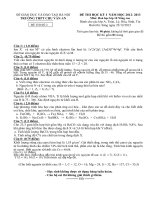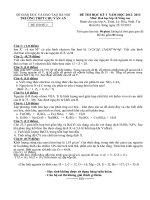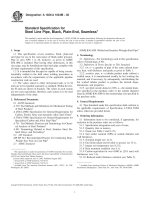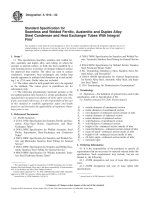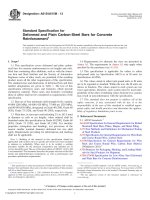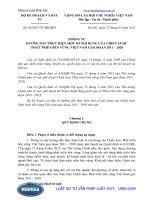Astm a 838 02 (2013)
Bạn đang xem bản rút gọn của tài liệu. Xem và tải ngay bản đầy đủ của tài liệu tại đây (89.59 KB, 4 trang )
Designation: A838 − 02 (Reapproved 2013)
Standard Specification for
Free-Machining Ferritic Stainless Soft Magnetic Alloy Bar
for Relay Applications1
This standard is issued under the fixed designation A838; the number immediately following the designation indicates the year of
original adoption or, in the case of revision, the year of last revision. A number in parentheses indicates the year of last reapproval. A
superscript epsilon (´) indicates an editorial change since the last revision or reapproval.
2. Referenced Documents
1. Scope
2.1 ASTM Standards:3
A34/A34M Practice for Sampling and Procurement Testing
of Magnetic Materials
A340 Terminology of Symbols and Definitions Relating to
Magnetic Testing
A341/A341M Test Method for Direct Current Magnetic
Properties of Materials Using D-C Permeameters and the
Ballistic Test Methods
A582/A582M Specification for Free-Machining Stainless
Steel Bars
A596/A596M Test Method for Direct-Current Magnetic
Properties of Materials Using the Ballistic Method and
Ring Specimens
A773/A773M Test Method for dc Magnetic Properties of
Materials Using Ring and Permeameter Procedures with
dc Electronic Hysteresigraphs
E1019 Test Methods for Determination of Carbon, Sulfur,
Nitrogen, and Oxygen in Steel, Iron, Nickel, and Cobalt
Alloys by Various Combustion and Fusion Techniques
2.2 Other Standard:
IEC Publication 60404-7 Methods of Measurement of the
Coercivity of Magnetic Materials in an Open Magnetic
Circuit4
1.1 This specification covers free-machining ferritic stainless soft magnetic alloy produced or supplied expressly in
cold-finished bar form for use in magnetic cores and other parts
requiring a high permeability, low-coercivity stainless steel.
1.1.1 This specification does not cover either cast parts or
parts produced by powder metallurgy techniques.
1.2 Two specific alloy types are covered. The primary
constituents are shown in Table 1. These types have corrosion
resistance similar to AISI Type 430F and Type 430F, Specification A582/A582M.
1.3 This specification covers only these alloy types supplied
in cold-finished bars in cross-sectional shapes such as rounds,
squares, hexagons, and octagons with diameters (diagonals)
greater than or equal to 0.250 in. (6.35 mm) and less than or
equal to 1.625 in. (41.28 mm).2
1.4 Certain cold-finished round bar products are capable of
being supplied mill annealed to required magnetic properties
such as low coercivity. The size range that can be mill annealed
is from 0.250 to 1.625 in. (6.35 to 41.28 mm). Other products
of these alloys cannot be mill annealed to produce equivalently
low coercivity; hence, the final machined parts should be heat
treated as recommended by the producer.
1.5 The values stated in customary (cgs-emu and inchpound) units are to be regarded as standard. The values given
in parentheses are mathematical conversions to SI units which
are provided for information only and are not considered
standard.
3. Terminology
3.1 The terms and symbols used in this specification are
defined in Terminology A340.
4. Classification
4.1 Two specific alloy types are covered:
1
This specification is under the jurisdiction of ASTM Committee A06 on
Magnetic Properties and is the direct responsibility of Subcommittee A06.02 on
Material Specifications.
Current edition approved May 1, 2013. Published July 2013. Originally approved
in 1985. Last previous edition approved in 2007 as A838 – 02 (2007). DOI:
10.1520/A0838-02R13.
2
Other product forms can be supplied to the chemistries listed in this specification; however, all other requirements shall be subject to negotiation between the
producer and the user.
3
For referenced ASTM standards, visit the ASTM website, www.astm.org, or
contact ASTM Customer Service at For Annual Book of ASTM
Standards volume information, refer to the standard’s Document Summary page on
the ASTM website.
4
Available from American National Standards Institute (ANSI), 25 W. 43rd St.,
4th Floor, New York, NY 10036, .
Copyright © ASTM International, 100 Barr Harbor Drive, PO Box C700, West Conshohocken, PA 19428-2959. United States
1
A838 − 02 (2013)
TABLE 1 Alloy Types
Alloy Type
Carbon
0.05
0.05
1
2
TABLE 3 Grades for Alloy Type 2
Grade
1
2
Nominal Composition, Weight Percent
Chromium
Silicon
Sulfur
Iron
17.5
0.50
0.30
balance
17.5
1.25
0.30
balance
4.2 Grades, Alloy Type 1—The standard grades of this alloy
type are distinguished by the as-supplied condition, coercivity,
and nominal mechanical hardness and are listed in Table 2.
two different sets of coercive field strength requirements, one
for ring and permeameter testing and one for coercimeter
testing, are given. Unless specified in the purchase order,
coercimeter testing shall be the standard test method.
4.3 Grades, Alloy Type 2—The standard grades of this alloy
type are distinguished by the as-supplied condition, coercivity,
and nominal mechanical hardness and are listed in Table 3.
8.2 Test Specimen—Test specimen size and shape shall be in
accordance with the requirements listed in Practice A34/
A34M. If tests on heat-treated specimens are requested, all
machining operations shall be performed before heat treatment.
The cross-sectional area of all specimen types shall be determined by measurement with a micrometer or calipers.
5. Ordering Information
5.1 Purchase orders for material under this specification
shall include the following information to adequately describe
the desired product:
5.1.1 Reference to this specification and year of issue/
revision.
5.1.2 Alloy type and grade (Section 4),
5.1.3 Form and condition,
5.1.4 Dimensions and tolerances (Section 9),
5.1.5 Quantity (weight or number of pieces),
5.1.6 Magnetic property requirements if other than shown in
this specification.
5.1.7 Certification of analysis or magnetic quality
evaluation, or both, if needed,
5.1.8 Marking and packaging, and
5.1.9 Exceptions to the specification or special requirements.
8.3 Magnetic Test Specimen Heat Treatment—When specified on the purchase order, the annealed magnetic properties
(also referred to as the magnetic capability) rather than the
as-supplied magnetic properties shall be determined. The heat
treatment to be used to assess the magnetic capability should be
specified by the user. If not, the following heat treatment
procedure (full anneal) shall be used.
8.3.1 Atmosphere—High vacuum or very dry hydrogen
(dew point less than −60°C).
8.3.2 Soak Temperature (Alloy Type 1)—815 6 25°C.
8.3.3 Soak Temperature (Alloy Type 2)—850 6 25°C.
8.3.4 Soak Time—2-h minimum.
8.3.5 Cooling—Furnace cool (50 to 100°C/h) to 400°C then
cool to room temperature at any convenient rate.
6. Chemical Composition
6.1 The material shall conform to the requirements prescribed in Table 4.
8.4 dc Ring and Permeameter Testing:
8.4.1 Either ring or permeameter test methods may be used.
For ring testing, a link-type specimen with its long edge
parallel to the bar axis is preferred. Testing of ring or link
specimens shall be in accordance with Test Methods A596/
A596M or A773/A773M. Testing of bar specimens on a
permeameter shall be in accordance with either Test Methods
A341/A341M or A773/A773M.
8.4.2 Requirements—The coercive field strength, when
measured from a maximum flux density of 10.0 kG (1.00 T),
shall meet the requirements listed in Table 5. Full-anneal
requirements refer to specimens heat treated in accordance
with 8.3.
6.2 Determination of metallic constituents shall be by a
method acceptable to both the producer and the user. Analysis
of carbon, nitrogen, sulfur, and oxygen shall be done in
accordance with Test Methods E1019.
7. Form and Condition
7.1 Cold Finished Bars—Cold drawn; cold drawn and
centerless ground; cold drawn and precision ground; mill
annealed and centerless ground; mill annealed and precision
ground.
8. Magnetic Property Requirements
8.5 Coercimeter Testing:
8.5.1 Coercimeter testing is permitted provided it can be
demonstrated that the maximum flux density induced in the
specimen exceeds 13 kG (1.30 T) and that the equipment and
procedures used satisfy the requirements of IEC Publication
60404-7.
8.5.2 Any machining before testing shall be done with due
care, and only enough material shall be removed to permit
insertion of the test specimen into the coercimeter.
8.5.3 Requirements—The coercive field strength shall meet
the requirements listed in Table 6. Full-anneal requirements
refer to specimens heat treated in accordance with 8.3.
8.1 General—Material supplied under terms of this specification shall be tested using either ring, permeameter, or
coercimeter test methods. Only the coercive field strength (Hc)
is subject to specification. Since coercimeters saturate the test
specimen before measurement of the coercive field strength,
TABLE 2 Grades for Alloy Type 1
Grade
1
2
3
As-Supplied Condition
mill annealed
unannealed, cold drawn
As-Supplied Condition
mill annealed
mill annealed
unannealed, cold drawn
2
A838 − 02 (2013)
TABLE 4 Chemical Requirements
Alloy Type
Carbon, max
1
2
0.065
0.065
Manganese,
max
0.80
0.80
Silicon
0.30/0.70
1.00/1.50
Phosphorus,
max
0.030
0.030
Sulfur
Chromium
0.25/0.40
0.25/0.40
17.25/18.25
17.25/18.25
Molybdenum,
max
0.50
0.50
Nickel, max
Iron
0.60
0.60
bal
bal
TABLE 5 DC Coercive Field Strength (Hc) Requirements—Ring and Permeameter Testing
Alloy Type
Grade
1
1
1
2
1
1
2
3
full anneal (all grades)
1
2
2
2
full anneal (all grades)
Bar Diameter Range, in. (mm)
$0.250 (6.35) #0.6875 (17.46)
>0.6875 (17.46) #1.625 (41.28)
$0.250 (6.35) #0.6875 (17.46)
>0.6875 (17.46) #1.625 (41.28)
$0.250 (6.35) #1.625 (41.28)
$0.250 (6.35) #1.625 (41.28)
$0.250 (6.35) #0.6875 (17.46)
>0.6875 (17.46) #1.625 (41.28)
$0.250 (6.35) #1.625 (41.28)
$0.250 (6.35) #1.625 (41.28)
Hc, max
2.30
3.00
4.70
5.00
7.00
2.20
2.60
2.80
7.00
2.60
Oe
Oe
Oe
Oe
Oe
Oe
Oe
Oe
Oe
Oe
2.90
3.60
6.00
6.60
8.50
2.80
3.40
3.60
8.50
3.40
Oe
Oe
Oe
Oe
Oe
Oe
Oe
Oe
Oe
Oe
(183 A/m)
(239 A/m)
(374 A/m)
(398 A/m)
(557 A/m)
(175 A/m)
(207 A/m)
(223 A/m)
(557 A/m)
(207 A/m)
TABLE 6 Coercive Field Strength (Hc) Requirements—Coercimeter Testing
Alloy Type
Grade
1
1
1
2
1
1
2
3
full anneal (all grades)
1
2
2
2
full anneal (all grades)
Bar Diameter Range, in. (mm)
$0.250 (6.35) #0.6875 (17.46)
>0.6875 (17.46) #1.625 (41.28)
$0.250 (6.35) #0.6875 (17.46)
>0.6875 (17.46) #1.625 (41.28)
$0.250 (6.35) #1.625 (41.28)
$0.250 (6.35) #1.625 (41.28)
$0.250 (6.35) #0.6875 (17.46)
>0.6875 (17.46) #1.625 (41.28)
$0.250 (6.35) #1.625 (41.28)
$0.250 (6.35) #1.625 (41.28)
9. Dimensions and Tolerances
9.1 Dimensions and tolerances shall be as mutually agreed
upon between the user and the producer.
Hc, max
(231 A/m)
(286 A/m)
(477 A/m)
(525 A/m)
(676 A/m)
(223 A/m)
(271 A/m)
(286 A/m)
(676 A/m)
(271 A/m)
11.2 Material furnished under this specification shall be
identified by the name or symbol of the producer, by alloy type
and grade, or producer’s brand name, or a combination thereof,
heat number, and material size. Each heat supplied on a given
order must be identified separately and packaged separately.
10. Certification
10.1 When specified in the purchase order or contract, the
user shall be furnished certification that samples representing
each lot have been either tested or inspected as directed in this
specification and the requirements have been met. When
specified in the purchase order or contract, a report of test
results shall be furnished.
12. Keywords
12.1 coercive field strength; coercivity; ferritic stainless
steel; free-machining; relay
11. Packaging and Package Marking
11.1 Packaging and package marking shall be subject to
agreement between the user and the producer.
3
A838 − 02 (2013)
APPENDIX
(Nonmandatory Information)
X1. TYPICAL PHYSICAL, MAGNETIC, AND MECHANICAL PROPERTIES
due to limitations associated with testing large-diameter, relatively high-permeability bars on a permeameter. Typical mechanical property data other than hardness for Grade 1 of both
alloy types is shown in Table X1.2. Typical hardness ranges are
given in Table X1.3. The data provided are for information
only and are not requirements in this specification and need not
be measured.
X1.1 Typical physical and magnetic properties are listed in
Table X1.1 for the two alloy types contained in this specification. Magnetic property data shown were measured on 0.250to 0.375-in. (6.35- to 9.52-mm) diameter mill-annealed (Grade
1—both types) bar using a Fahy Permeameter in accordance
with Test Method A341/A341M. Larger-diameter bars will
yield lower maximum permeabilities and residual inductions
TABLE X1.1 Typical Physical and Magnetic Properties
Property
Density, g/cm3 (kg/m 3)
Electrical resistivity, µΩ-cm (µΩ-mm)
Mean coefficient of thermal expansion,
(0–649°C) (µm/m/°C)
Curie temperature, °C
Saturation flux density, kG (T)
(Relative) maximum permeability
Residual induction,A kG (T)
Coercive field strength,A Oe (A/m)
A
Alloy Type 1
Alloy Type 2
7.62 (7620)
60.0 (600)
(11.9)
7.59 (7590)
76.0 (760)
(11.9)
671
15.5 (1.55)
2300
7.54 (0.754)
1.80 (143)
660
15.2 (1.52)
2350
7.42 (0.742)
1.64 (130)
Residual induction and coercive field strength are determined from a maximum flux density of 10 kG (1.0 T).
TABLE X1.2 Typical Mechanical Properties—Grade 1
Property
Alloy Type 1
Alloy Type 2
0.2 % yield strength, ksi (MPa)
Ultimate tensile strength, ksi (MPa)
Percent elongation in 2 in. (50.8 mm)
Percent reduction in area
45 (310)
75 (520)
20
60
50 (350)
78 (540)
30
60
TABLE X1.3 Typical Hardness
Alloy Type
Grade
1
1
1
1
2
3
2
2
1
2
Typical Hardness
75
82
85
92
80
85
92
to 82 HRB
to 91 HRB
HRB at midradius
HRB at surface
to 88 HRB
HRB at midradius
HRB at surface
ASTM International takes no position respecting the validity of any patent rights asserted in connection with any item mentioned
in this standard. Users of this standard are expressly advised that determination of the validity of any such patent rights, and the risk
of infringement of such rights, are entirely their own responsibility.
This standard is subject to revision at any time by the responsible technical committee and must be reviewed every five years and
if not revised, either reapproved or withdrawn. Your comments are invited either for revision of this standard or for additional standards
and should be addressed to ASTM International Headquarters. Your comments will receive careful consideration at a meeting of the
responsible technical committee, which you may attend. If you feel that your comments have not received a fair hearing you should
make your views known to the ASTM Committee on Standards, at the address shown below.
This standard is copyrighted by ASTM International, 100 Barr Harbor Drive, PO Box C700, West Conshohocken, PA 19428-2959,
United States. Individual reprints (single or multiple copies) of this standard may be obtained by contacting ASTM at the above
address or at 610-832-9585 (phone), 610-832-9555 (fax), or (e-mail); or through the ASTM website
(www.astm.org). Permission rights to photocopy the standard may also be secured from the ASTM website (www.astm.org/
COPYRIGHT/).
4

